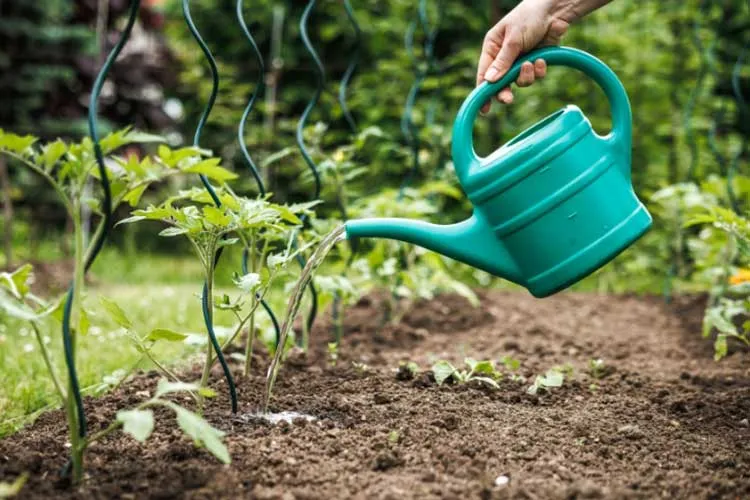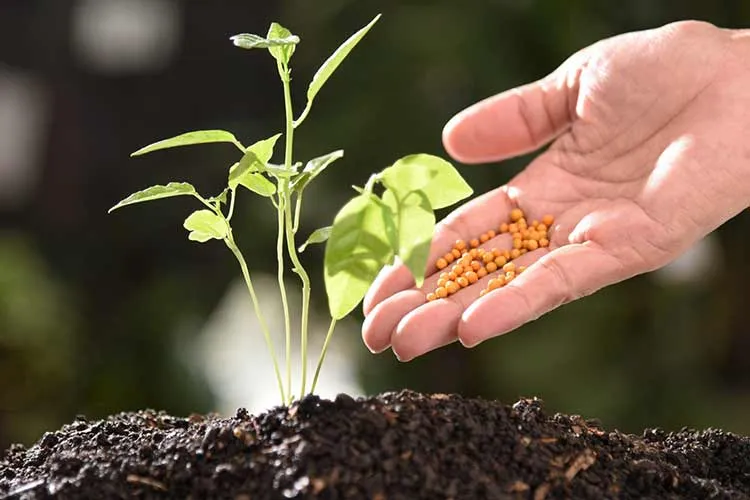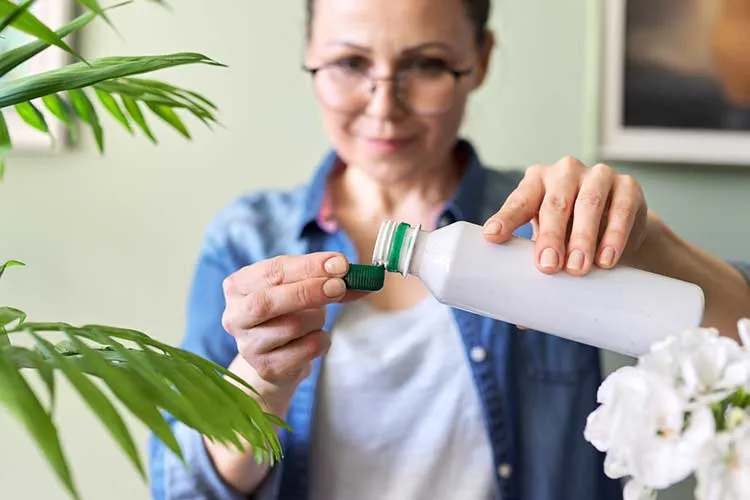Best Fertilizer for Tomatoes isn’t just a product — it’s the difference between a plant with five bland fruits and one with twenty rich, juicy tomatoes. Tomato plants are heavy feeders; without the right nutrients at the right time, even healthy-looking vines can fail to produce.
Over 70% of poor tomato yields result from feeding mistakes, including excessive nitrogen, insufficient phosphorus, or a lack of calcium. If you’ve ever asked yourself why your tomato plants look great but barely fruit, fertilizer is likely the issue.
This guide strips out the guesswork. You’ll learn exactly what your tomatoes need at each growth stage, how to read NPK ratios, when to feed, and what to buy (or make) for maximum fruit production — no wasted time, no wasted harvest.
What Makes a Tomato Thrive? A Look at Nutrients and Plant Needs
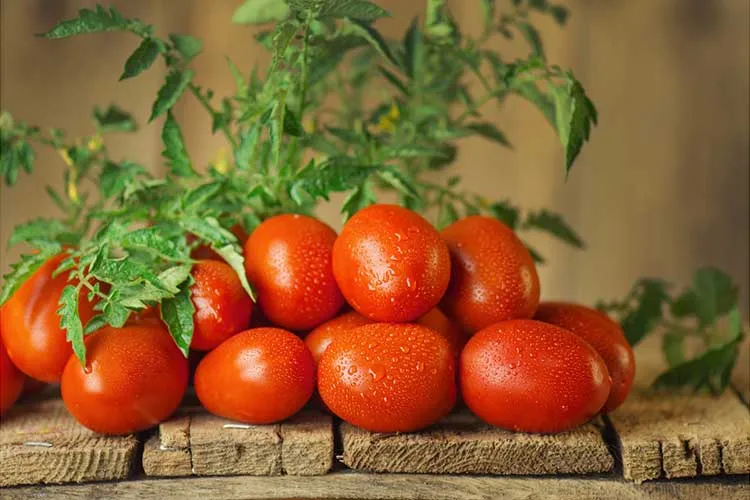
Tomatoes are hungry plants, and to grow healthy vines loaded with fruit, you’ll need more than just water and sun. It starts with understanding what nutrients tomatoes use — and when.
First, nitrogen (N) is what fuels the growth of leafy greens. Early in the season, nitrogen helps seedlings and young transplants get established. But here’s the catch: too much nitrogen later on will give you a jungle of leaves with barely any fruit. You’ll need to ease up once the plant starts flowering.
Phosphorus (P) is the powerhouse for root growth and fruit development. Tomato plants crave phosphorus once they begin to flower. It encourages blossoms to form and helps set strong, healthy fruits. A phosphorus boost may be the fix if your tomato plants aren’t flowering well or dropping blossoms.
Potassium (K), conversely, aids in the ripening process, enhancing fruit size, flavor, and disease resistance. A fertilizer high in potassium, especially after fruit starts forming, helps build picture-perfect tomatoes that taste like summer in every bite.
Don’t overlook calcium and magnesium either. Calcium prevents blossom-end rot, which shows up as black, sunken spots on the bottom of the fruit. Magnesium helps keep the leaves green and strong, supporting photosynthesis and nutrient transport.
Tomato Fertilizer 101: Understanding NPK Ratios
Those three bold numbers on every fertilizer bag? They’re more than labels — they’re your blueprint for tomato success. These numbers stand for Nitrogen (N), Phosphorus (P), and Potassium (K), in that order. This is known as the NPK ratio, which indicates the percentage of each nutrient in the mix.
Here’s how it works: a fertilizer labeled 5-10-10 contains 5% nitrogen, 10% phosphorus, and 10% potassium. So, how does that affect your tomatoes?
Early in the season, when your plants are young, they benefit from more nitrogen to fuel leafy growth and build a strong framework. But once flowers start to form, it’s time to switch gears. Now your tomatoes need more phosphorus and potassium — these nutrients encourage blooms, help set fruit, and increase tomato fruit size.
Excessive nitrogen during flowering or fruiting can harm your harvest. You’ll get big green plants with few flowers and small fruit. Switching to a 5-10-10 or 4-6-8 blend at flowering time can make all the difference.
Remember that some fertilizers are labeled “tomato food” and that this balance has already worked out. But if you’re mixing your own or picking between options, knowing how to read the NPK ratio helps you choose one that feeds your plants exactly what they need — no guessing.
Choosing the Right Tomato Fertilizer (Natural vs Synthetic)
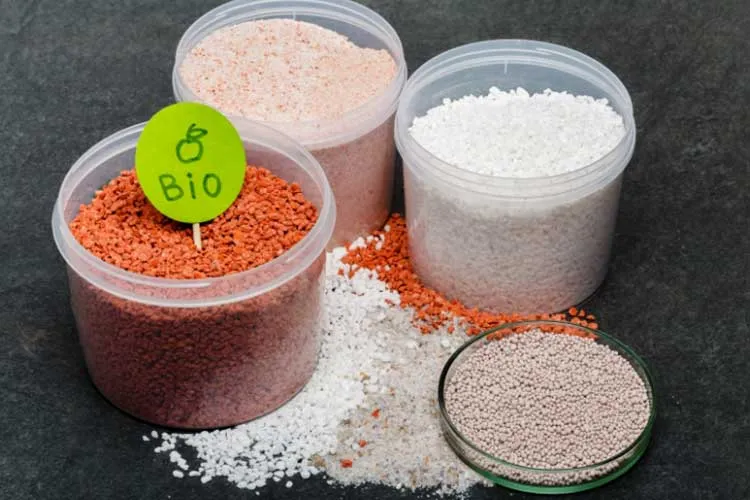
Now that you understand what those numbers mean, the next question is: Should you opt for natural or synthetic? Both have their place, but they work differently, and one might suit your garden style better.
Synthetic fertilizers, like Miracle-Gro Tomato Plant Food, are fast-acting. They’re water-soluble and deliver nutrients right away. So synthetic options can perk them up in just days if your plants look pale or sluggish and you need a quick fix. But there’s a trade-off: they don’t improve your soil long-term, and if overused, they can burn roots or create salt buildup.
Natural or organic fertilizers — like compost, fish emulsion, kelp meal, or Espoma Tomato-Tone — feed your plants and soil. They release nutrients slowly, improving soil structure, moisture retention, and microbial life. That means better growth over time and stronger, more resilient plants. The downside? You won’t see instant results, which can sometimes be more costly.
So, what is the best natural fertiliser for tomatoes? That depends on what you have access to and the amount of effort you’re willing to put in. A balanced organic fertilizer, like Tomato-Tone, offers a strong blend of plant-based and mineral ingredients. It’s gentle but effective and includes calcium to help prevent blossom-end rot. Compost and worm castings are excellent soil boosters, especially when added before planting.
For many gardeners, a mix of both styles works best: use a slow-release organic base at planting, then give a synthetic boost mid-season if plants need extra help.
Is 10-10-10 Fertilizer Good for Tomatoes? Pros and Pitfalls
Many gardeners use 10-10-10 fertilizer, but is it good for tomatoes? The short answer is sometimes, but it depends on the timing.
A 10-10-10 blend offers equal parts nitrogen, phosphorus, and potassium. That makes it a balanced, general-purpose fertilizer, which can be helpful early in the season when tomato plants are small and need support in all areas. You’ll experience strong initial growth, solid root development, and sufficient potassium to get things started.
However, here’s where it gets tricky. Once your tomato plant starts flowering and forming fruit, that blend is no longer balanced. The nitrogen is now too high compared to what the plant needs. If you continue using it at this stage, you may end up with many bushy leaves and very few tomatoes. It’s like feeding a teenager candy during finals week — energy’s going to the wrong place.
So, while 10-10-10 can be helpful as a starter fertilizer, you’ll want to transition to something with more phosphorus and potassium, like a 5-10-10 or 4-6-8, once your plant enters the flowering stage. Alternatively, if you’re using a long-release 10-10-10, apply it sparingly and use it only at the start of the season.
The bottom line is that 10-10-10 is a good early option, but it is not your best bet for a fruit-heavy harvest.
Best Fertilizer for Tomatoes to Buy Right Now
With so many tomato fertilizers on the shelf, it’s easy to get overwhelmed. Here’s a breakdown of top-rated picks that gardeners swear by — whether you want quick results, long-term soil health, or both. Each one supports strong fruiting and flavor, and they’re all easy to find online or at garden centers.
1. Miracle-Gro Tomato Plant Food
A fast-acting synthetic option that’s great for an instant green-up and quick fruit development. It’s water-soluble and easy to apply every 1–2 weeks. Be cautious — too much can lead to leafy plants with few tomatoes.
Good for: mid-season boosts
Is Miracle-Gro good for tomatoes? Yes, when used in moderation and at the right time.
2. Espoma Tomato-Tone Organic Fertilizer
Loved by organic growers for its gentle but effective formula. It’s a slow-release granular mix with calcium to prevent blossom-end rot. Made from plant and animal meals, it feeds the plant and soil microbes.
Good for: planting time and consistent feeding all season
NPK: 3-4-6
3. Jobe’s Organic Tomato Fertilizer Spikes
There is no mixing, no mess—push these spikes into the soil near your plant. Their slow release makes them beginner-friendly and low-maintenance. They are certified organic and have a Biozome to boost soil health.
Good for: container growers or hands-off fertilizing
NPK: 2-7-4
4. Dr. Earth Home Grown Tomato, Vegetable & Herb Fertilizer
Another top organic pick, loaded with beneficial microbes and mycorrhizae. It’s especially helpful for improving soil in raised beds and garden plots. A great all-around option for building soil fertility over time.
Good for: garden beds and long-term health
NPK: 4-6-3
5. FoxFarm Big Bloom Liquid Concentrate
A liquid organic fertilizer that’s made from worm castings and bat guano. It’s lower in nitrogen but higher in phosphorus and potassium, which makes it ideal for the flowering and fruiting stages.
Good for: boosting flower and fruit production mid-season
NPK: 0.01-0.3-0.7
For optimal results, match your fertilizer to your plant’s stage of growth. Start slowly and steadily, then gradually increase potassium and phosphorus when it’s time for fruit. And keep a watering schedule—even the best fertilizer won’t help if your tomatoes are stressed from dry roots.
Fertilizing Schedule: When and How Often to Feed
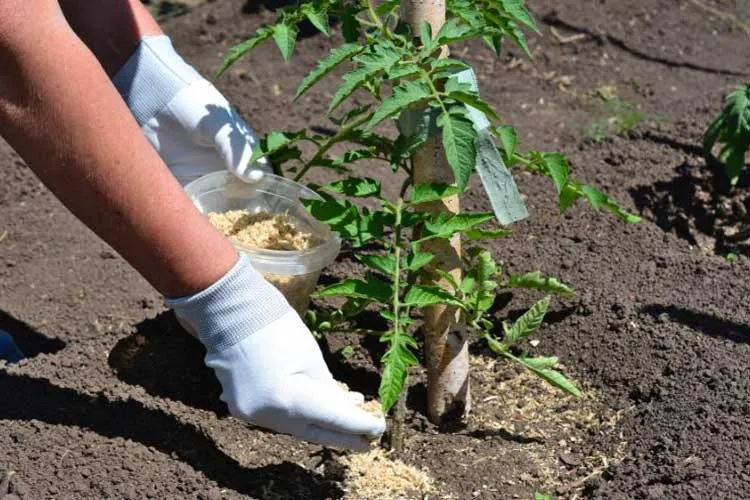
Feeding your tomatoes at the right time is just as important as what you feed them. Overdoing it too early or too late can lead to leggy vines, small fruit, or even burned roots. Here’s a simple, step-by-step breakdown to keep your plants on track throughout the season.
1. Seedling Stage (Week 0–3)
If you’re starting tomatoes indoors, skip the fertilizer until the first true leaves appear. Then, use a diluted liquid fertilizer, like fish emulsion at 1/4 strength, once every 10–14 days. Too much nitrogen here will cause the seedlings to grow too quickly.
2. Transplanting (Week 3–4)
Before planting outdoors, mix a slow-release granular fertilizer into the hole or garden bed. Organic blends, such as Tomato-Tone or Dr. Earth, are great at this stage. Water it thoroughly to help the nutrients start working.
3. Pre-Flowering (Week 4–6)
Now’s the time to support early growth. A balanced fertilizer, such as 5-5-5 or 10-10-10, can help build a strong root system and sturdy stems. Apply every 2–3 weeks, or follow the instructions on your fertilizer’s label.
4. Flowering & Fruit Set (Week 6–8)
Switch to a fertilizer with a lower nitrogen content and higher phosphorus and potassium levels, such as 3-4-6 or 2-7-4. Apply it when flowers begin to form. This helps the plant focus on blooming and setting fruit rather than growing more leaves.
5. Mid-Season Maintenance (Week 8 and beyond)
Once your plant produces fruit, feed every 2–4 weeks with a low-nitrogen fertilizer or compost tea. Don’t overdo it — too much food at this point can delay ripening. Look for signs like leaf curl or yellowing to tell if your plants are underfed or overfed.
Quick Tip:
Always water before and after fertilizing. Dry roots absorb too fast, which can cause burn. And avoid fertilizing right before heavy rain — nutrients can wash away before plants absorb them.
DIY Tomato Fertilizers: Recipes That Work
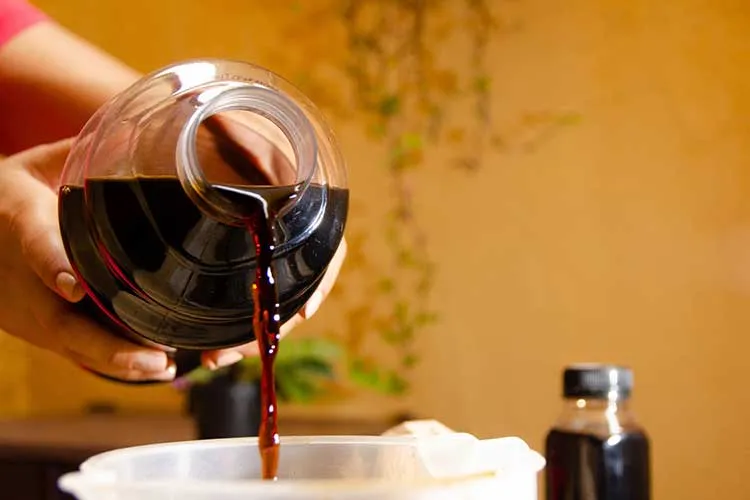
If you like to keep things low-cost or chemical-free, homemade tomato fertilizers can be surprisingly effective — and made from stuff you already have. Here are three easy recipes that work well in most backyard gardens.
1. Compost Tea
This is a garden classic that feeds both plants and soil. Fill a 5-gallon bucket with water and add a shovel full of finished compost. Let it steep for 1–2 days, stirring occasionally. Strain and water your plants with it every 2–3 weeks during the fruiting period.
Why it works: It adds a balanced mix of nutrients and boosts beneficial microbes.
2. Crushed Eggshells + Banana Peel Soak
Save eggshells and banana peels in a jar of water for 3–5 days. The calcium from shells helps prevent blossom-end rot, and banana peels produce potassium. Use this mix as a watering supplement during flowering.
Why it works: A Simple way to boost fruit quality and prevent common tomato problems.
3. Epsom Salt + Baking Soda Mix
Mix 1 tablespoon of Epsom salt and 1/2 teaspoon of baking soda into a gallon of water. Apply once a month.
Why it works: Epsom salt’s magnesium helps with leaf health and photosynthesis, and baking soda can lower fungal stress.
Are you wondering how to make tomato fertilizer yourself without overthinking it? Start with compost tea and add from there. Most DIY options work best with solid soil prep and regular watering.
Epsom Salt, Coffee Grounds & More: Tomato Fertilizing Myths vs Facts
Tomato growers love sharing tips — but not all are backed by results. So, let’s break down some of the most talked-about garden tricks and separate what helps from what sounds helpful.
What does Epsom salt do to tomatoes?
Epsom salt is made of magnesium sulfate, which provides magnesium, an important micronutrient that supports leaf health and helps with photosynthesis. If your plants are exhibiting yellow leaves with green veins (indicating a magnesium deficiency), adding Epsom salt can be beneficial. Mix 1 tablespoon per gallon of water and apply as a foliar spray every 2–4 weeks.
Myth or fact? For the most part, factual, but it’s not a miracle cure. Use it only if your soil is deficient in magnesium.
Are coffee grounds good for tomato plants?
Coffee grounds are rich in nitrogen and can help with slow-release feeding if composted first. They also improve soil texture and attract worms. But used fresh, they’re a bit acidic and can clump together, restricting airflow.
Myth or fact? A little of both. Compost them first or mix lightly into the soil — don’t dump piles of wet grounds around your plants.
Banana peels = potassium boost?
Yes, but only if they’re broken down. Burying whole peels won’t help fast. Chop or soak them in water first.
Fact: Good slow-release potassium source when composted or soaked.
Eggshells stop blossom-end rot?
Eggshells add calcium to the soil but take time to break down. They won’t instantly fix rot, especially if watering is inconsistent, which is often the real issue.
Mostly myth: Helpful in the long term, but not a quick fix.
Does aspirin water boost tomato immunity?
Some gardeners swear by dissolving an aspirin in water and spraying it on the leaves of tomatoes. Salicylic acid may stimulate a plant’s natural defenses.
Anecdotal at best: Interesting idea, but results vary. Not a replacement for healthy soil and nutrients.
Bottom line? Stick to practices that match your soil’s actual needs. A soil test is more helpful than garden hearsay.
Miracle-Gro and Other Popular Picks: Are They Worth It?
It’s easy to spot Miracle-Gro on store shelves — it’s everywhere. But is Miracle-Gro good for tomatoes, or is it overhyped? Here’s what to know before reaching for that bright blue box.
Miracle-Gro Tomato Plant Food is a water-soluble fertilizer designed to give fast results. An NPK of 18-18-21 packs a strong punch, especially in the potassium department. This can work well if your plants are well-established and need a boost during flowering or fruit set. It’s easy to mix, and results often show within days.
Here’s the catch: It’s strong. If you’re not careful, it’s easy to overdo it and cause fertilizer burn, especially in potted plants or when the soil is already rich. Also, it doesn’t improve your soil structure, so it’s more like fast food for your plants.
In comparison, organic fertilizers like Espoma Tomato-Tone or Dr. Earth work more slowly but support long-term soil health. They’re gentler, less likely to cause problems, and often include extras like calcium and beneficial microbes.
So, are these popular picks worth it?
Yes, when used for the right reason. Miracle-Gro is useful for a mid-season pick-me-up or when plants appear stressed and need immediate help. However, an organic blend is the better option for routine feeding and yields better soil year after year.
If you’re growing in containers or dealing with poor soil, it may make sense to use both — organic matter for base nutrition and Miracle-Gro as an occasional supplement.
Tomato Fertilizer FAQs (Answering What Everyone’s Googling)
There’s no shortage of questions when it comes to feeding tomato plants. Here’s a straight-to-the-point roundup of the most common ones, so you can skip the guesswork and focus on growing.
Can I use the same fertilizer for all vegetables?
Not always. Tomatoes are heavier feeders than leafy greens or herbs. While a general-purpose fertilizer like 10-10-10 can work well for many vegetables, tomatoes often perform better with a higher phosphorus and potassium content, especially during flowering. If you’re growing multiple crops, use a balanced fertilizer early, then switch to tomato-specific formulas once fruiting starts.
Do tomatoes like acidic fertilizer?
Tomatoes prefer slightly acidic soil, in the pH range of 6.0 to 6.8. Most fertilizers don’t directly acidify the soil, but some organic ones — such as composted manure or coffee grounds — can gradually lower the pH over time. If your soil is too alkaline, using a tomato fertilizer with sulfur or adding peat moss may help.
How do I know if I over-fertilized?
Signs include deep green, bushy plants with no fruit, leaf curl, brown or crispy edges, or white crust on the soil surface (especially in containers). If you notice this, flush the soil with water and skip feeding for a few weeks. Always follow label directions and don’t apply when the soil is bone dry.
Should I fertilize tomatoes after it rains?
Light rain usually isn’t a problem, but heavy rain can wash nutrients from the soil, especially in sandy or loose beds. If your area gets a long soak, it’s fine to reapply a mild fertilizer after things dry out a bit. Rain can leach nutrients even faster for container plants, so keep a closer eye on them.
Can I mix different fertilizers?
You can, but do it carefully. Mixing synthetic and organic products is common, but avoid using multiple nitrogen-heavy products. If you’re blending, choose one as your main source and use the other sparingly. When in doubt, opt for lighter applications and space them out.
How do I fertilize tomatoes in pots or containers?
Container plants lose nutrients more quickly, so they require more frequent feeding. Use a slow-release granular when planting, then supplement with liquid fertilizer every 2–3 weeks. Just be sure your pots have good drainage — too much water and food with nowhere to go is a recipe for root rot.
What’s the easiest feeding routine for beginners?
Start with a balanced organic fertilizer at planting, then switch to a tomato-specific blend, such as 3-4-6, once flowering begins. Feed every 2–4 weeks, and skip the extras unless your plant shows signs of stress. Water deeply before and after feeding, and maintain this consistency.
Still unsure? A simple soil test kit can tell you exactly what’s missing — and what you don’t need to add.

